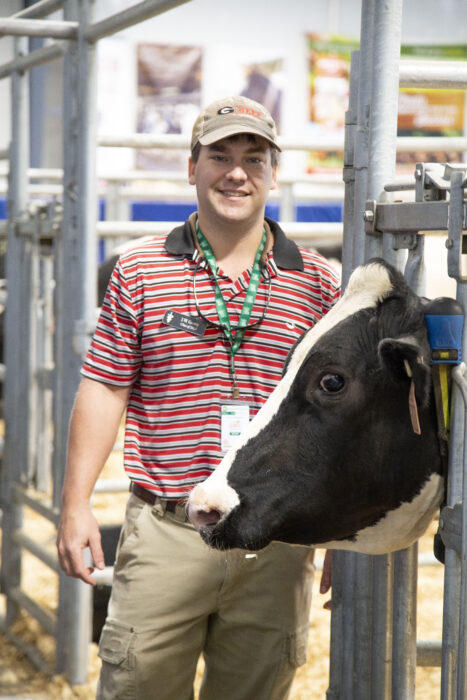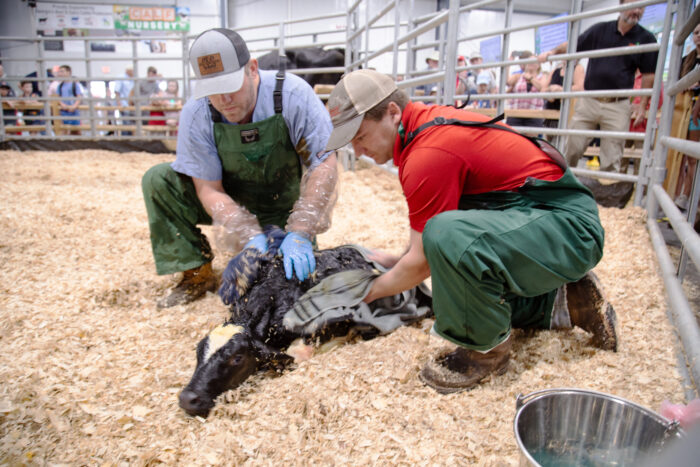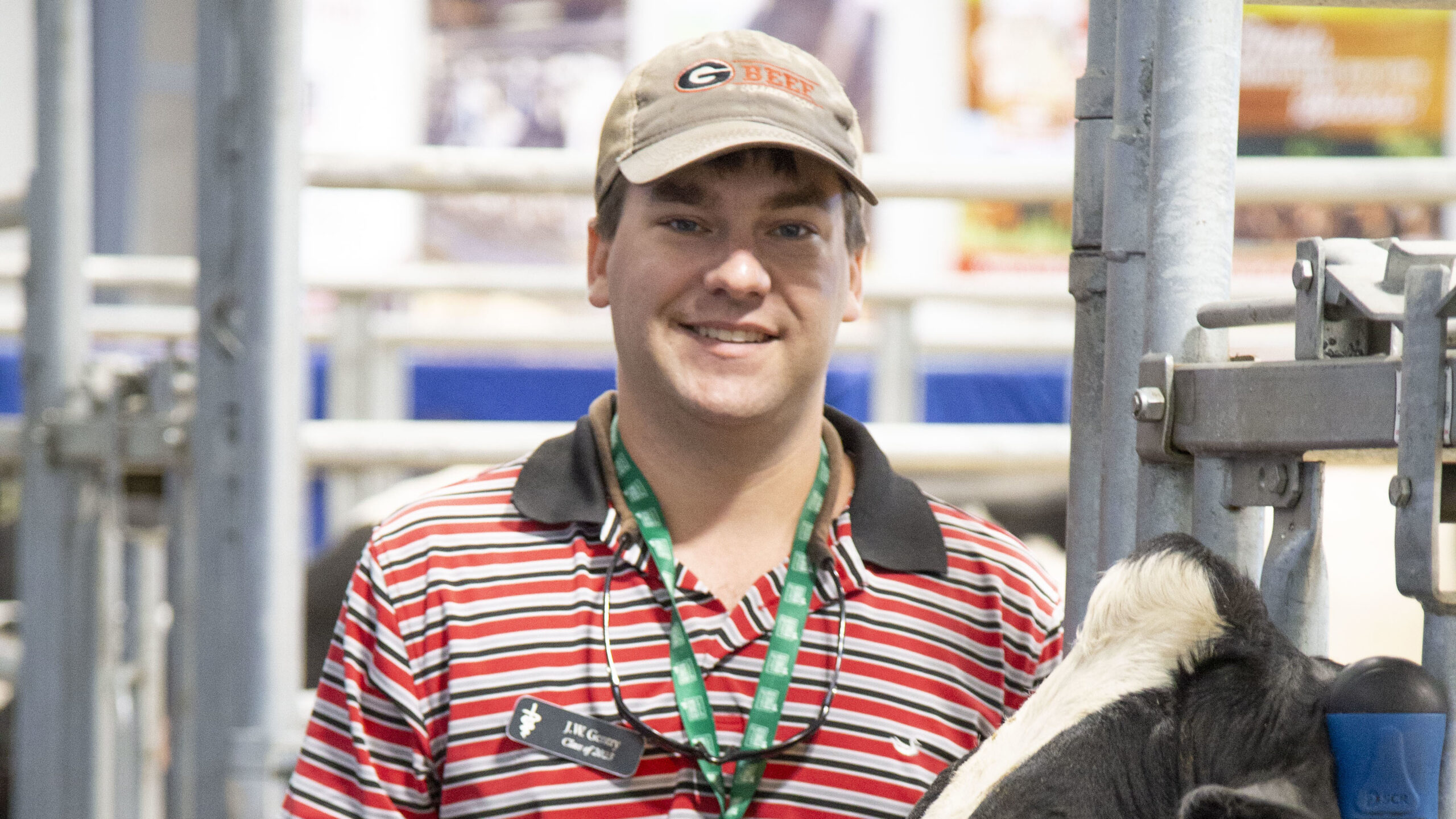J.W. Gentry (DVM, 2023) will take his learning home to Middle Georgia to assist food animal producers

The Georgia Grown Baby Barn offers those attending the Georgia National Fair in Perry each October a chance to witness the birth of dairy calves. (Amy Carter/CVM)
Watching J.W. Gentry work the Georgia Grown Baby Barn at the Georgia National Fair in Perry is like watching a small-town mayor meet his constituents at a barbecue on the town square. Everybody knows and likes him, two truths made self-evident by the conversational circles that swallow him up whenever he walks the floor in plain clothes.
Once he dons the overalls and gloves of the large animal veterinarian he will soon become, strangers gather ‘round, too.
Gentry graduated with his Doctor of Veterinary Medicine degree from the University of Georgia’s College of Veterinary Medicine in May.
His desire to return to his hometown of Perry and join a mixed animal practice that cares for both companion animals and farm animals is unique, hence his presence at the baby barn in October of 2022. There is a critical need for large animal veterinarians to ensure quality care for food animals in the United States, but most veterinary students do not choose that path.
According to data compiled by CVM’s office of Clinical Academic Affairs, about 65 percent of members of the Class of 2022 declared their intent to enter small animal practice exclusively; 15 percent chose large animal practice; 10 percent declared for mixed animal practice; and five percent entered non-clinical settings such as research.
The baby barn is a joint venture of the Georgia Department of Agriculture and the Georgia National Fairgrounds and Agricenter that puts large animal veterinarians in the spotlight and offers fairgoers the opportunity to witness the live births of dairy calves as part of the fair-going experience. Traditionally CVM veterinary faculty oversee care of the cows during their stay at the fair.
In 2022, however, Gentry took the reins.
“He really stepped up and just kind of took the lead on everything,” says Brad Heins, associate clinical professor in the CVM’s Teaching Hospital in Athens. “We were there to provide support and oversight if he needed it, but for the most part we let J.W. lead the show and he did a great job with it. The Georgia Department of Agriculture was really happy with everything he did and accomplished.”
Learning by Doing
For an aspiring veterinarian keen on helping producers care for their herds, the baby barn offers more hands-on experience in 11 days than the real world offers in a single career. In October of 2022, the baby barn counted 33 births, which averages out to three per day. The dairy they come from has 15,000 cows in lactation and calves about 50 animals a day. An outside veterinarian is typically not involved in those births unless complications ensue.
Rather than allow the cows to calve in the pasture and bring mother and baby to the barn afterwards the way most dairies do, this dairy practices “just-in-time” birthing. The cows are kept in a barn and farm workers walk the barn looking for laboring mothers. Those cows are relocated to a separate pen, where they are observed while giving birth so that help is on hand should complications arise.
The baby barn is set up similarly, with a large pen in the center of the building where expectant mothers are kept as they enter the final stages of labor. The dairy selects cows from its stock that are expected to deliver within three days and sends them to the baby barn each morning before the fairgrounds open during the 11 days of the event each October.
Native Son
Gentry is no stranger to the fairgrounds. Born and raised in the environs around the sprawling facility that hosts agricultural events year-round, Gentry is the product of a family that “farmed everything under the sun” and then went back to school and earned doctorates in education.
“I’ve always enjoyed my community and that aspect of veterinary medicine where you can come back and make an impact on people that you know,” Gentry says. “I became a veterinarian because I enjoy the fact that no day is really the same. I don’t really discriminate on what I work on, I just want to be able to work on it all, to make a difference, make an impact and help my neighbors.”
Gentry and his father run a 50-head commercial cow/calf project that has taught him much more than classroom lessons, Gentry says. “It’s real life. It’s prepared me to make a difference with producers out there because I face the same battles. That’s really my purpose behind it, to have some skin in the game and hopefully convince people that the practices I’m preaching are good to follow and have an example to show why.”
Experience and exposure to the producers he hopes to serve after graduation are two big bonuses of Gentry’s time at the baby barn in 2022, but he and Heins were also engaged in their own informal study of the animals while there that will help ensure a healthy experience for the dairy and its cows in the future.
Baby Barn Becomes Lab

Dr. J.W. Gentry, at right, rubs a newborn dairy calf in the main ring at the Georgia National Fair in October 2022. The Baby Barn is a joint venture between the Georgia Department of Agriculture and UGA CVM that gives fairgoers a rare opportunity to witness the live birth of dairy calves. Gentry, who graduated May 2023, assisted in the delivery of most of the 33 calves born at the 2022 fair. (Amy Carter/CVM)
“The baby barn is a great opportunity to get the public exposed to farm animals and the birth process, but we’re bringing that cow from the dairy to the fair and we’re putting them in front of a bunch of other people,” Heins says. “It’s not that it’s stressful but it’s a change in environment with the number of people that come through there and other things.”
Although working with a statistically small sample, Gentry and Heins monitored mothers and calves at the fair and for 90 days after to study the effects on calf growth and vigor and the impact of the Baby Barn experience on feeding and milk production in the mama cows.
“One of the purposes of this was to really get JW thinking, ‘What are the issues we’re dealing with and how do we best manage them moving forward, and how can we do a better job at this in the future,’” Heins says.
“What we wanted to look at is by moving the cows from the dairy to the baby barn and then back to the dairy, are there any other issues that occur with that animal post-calving. Is there increased risk of metabolic disease or mastitis, things that we occasionally see after calving on a dairy.”
Just as in humans and other mammals, a new mother’s nutritional needs change dramatically after she gives birth and begins producing milk. If she’s off her feed or doesn’t eat enough of the right things, her body begins mobilizing her own fat and muscle (protein) stores to fuel lactation.
Heins notes that the risk of metabolic disease is low since mothers and calves are returned to the dairy soon after birth. And feed consumption naturally drops as calving approaches due to physical discomfort and hormonal changes.
“Our goal is to get them in and get them out as quickly as possible, so we reduce the risk of metabolic disease. The other thing we do is bring feed from dairy that these animals are already consuming. There’s no change in feed but the environment does change quite a bit and then we have a lot of people coming through.”
Though exhausted after 11 days of catching up with friends, explaining large animal care to fair goers with little to no farm experience, and tending to laboring cows and their calves, Gentry considered it a valuable learning experience.
“I just try to learn from every experience,” Gentry says. “I treat every patient like they’re the most important patient because they are. They’re the one in your hands right that second. That’s the perspective I try to take into it, and I feel like I’ve got the most out of my clinical rotations by doing that.”
